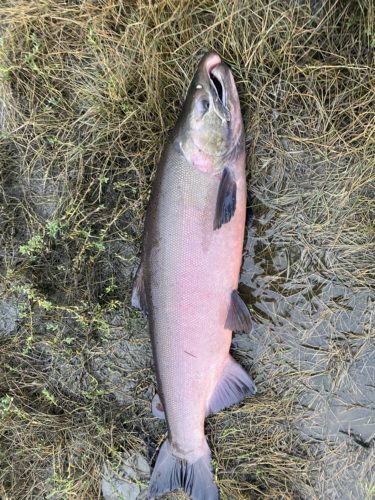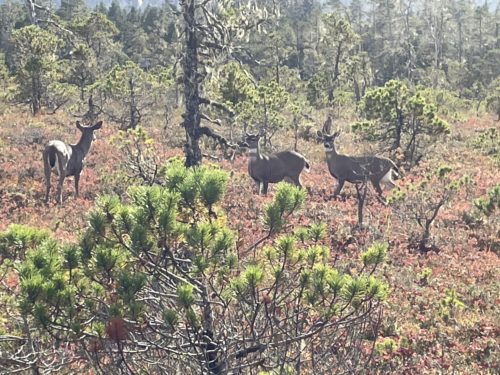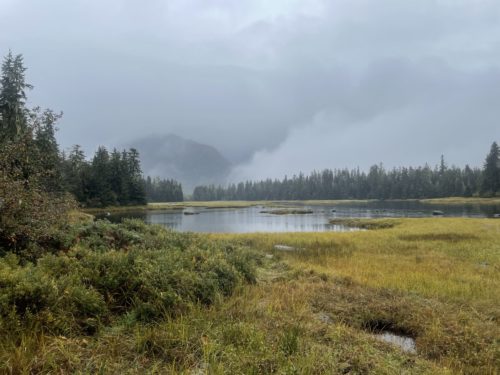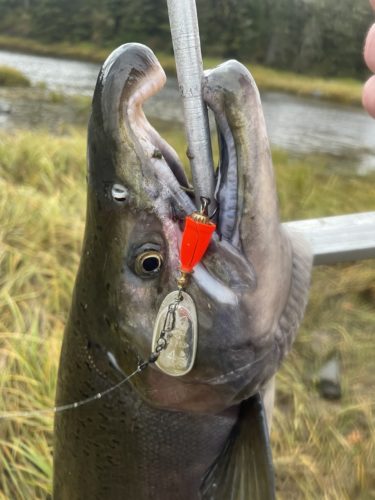
A Lower 48er’s Solo Silver Trip To Petersburg
The following appears in the December issue of Alaska Sporting Journal:

BY BRIAN KELLY
My annual treks to Alaska start with a planning session among the group of anglers who come along on these trips. Everyone checks their calendars and shares their input on the “where” and “when” the excursion takes place.
This trip was to be my 13th to Alaska, but it soon became apparent that it might become my first solo mission. Some of the group had other trips planned; some had those marriage-type-thing occasions, which were planned well in advance by someone who had no idea that it would coincide with the coho run.
My longtime Alaska travel partner and mentor, Jim Stepulkoski, was dealing with degenerative disc issues in his back and couldn’t make the trip for the first time since we landed in Anchorage in 2011.
However, he did offer some advice:
“You’ve done enough of these trips to the same places we have all been. Find a location, do your homework and test yourself.”
Before Jim first invited me along on these outings, he had done plenty of solo missions to Alaska, doing the legwork and figuring out the various silver and king fisheries that existed on the road system stemming out from Anchorage.
In recent years, we had branched out from those well-known locales to find some absolute gems in the Alaskan panhandle. One of those gems was forecast to have a poor silver return, so it became apparent that I needed to stick my neck out and find the next go-to Alaska silver run.
After some searching on the Alaska Department of Fish and Game website – I used their interactive map on the “GoFishAK” link – I came across the town of Petersburg in Southeast Alaska. The area checked off the boxes: accessible by Alaska Airlines; rental car availability; lodging; a combination of hatchery and wild fish that show up after Labor Day. After trading a few emails with the local fisheries biologist, I felt confident in my choice and began booking a solo adventure that was to be quite an eye opener.

PLANNING A TRIP WITH a group can get a bit hairy, given all the opinions about the “week we should be there.” At some point along the way, I was left in charge of the booking details. Some years we were early, some late, and others right on time for the peak of the run.
This planning comes with a bit of pressure – mostly self-induced – to get it right and make sure everyone gets their fish and actually enjoys themselves. That is a lot to ask, especially when the fragile male ego is involved.
The trip I was planning to Petersburg was a nice change. I didn’t have huge expectations going in, as this was a new venue. There weren’t weekly fishing reports or social media posts from the local lodges, so I truly was flying blind when I landed in Petersburg.
Getting to Petersburg was like getting to other Alaska Panhandle locations. First fly into Seattle, spend the night and jump on one of the milk run flights the next morning. My plane had a first stop in Ketchikan, and the plane was loaded with groups of other fishermen who would be getting off there and heading over to Prince of Wales Island to either a DIY camp or a fully guided lodge. The flight attendants knew who their clientele was, and kept one overhead bin available “just for fishing rods.” You’ll never hear or see such a thing in the Lower 48!
Upon landing, the majority of the plane unloaded and went off to start their adventures. Then, in true milk run fashion, the plane loaded back up – this time with hordes of teenagers and a few adults who looked to be coaches. It was, in fact, the Petersburg cross country team, which was heading home after a meet in Ketchikan, and the Ketchikan swim team, which was on its way to a meet in Juneau. Call it taxi transport, Alaska style!
We then departed for Wrangell, which was a quick flight, for the next round of drop-offs and pick-ups. However, we ended up stuck here for a bit longer than expected. Something in the cockpit wasn’t to the pilots liking, so we went back to the gate for a maintenance check. I have been on plenty of flights when these situations occur; it could be a slight delay or an overnight stay in a small, cramped airport.
We were only 50 miles from Petersburg, and that’s where the local maintenance person was located. So … it was going to be “awhile.”
Of course, the high school kids and their coaches got off the plane and walked to town for snacks, which meant the flight attendants brought out the drink cart for the remaining adults. Nothing soothes an unexpected layover like a cold beer!
It wasn’t looking good, as the maintenance guy was scratching his head while standing at the cockpit door. But the powers that be decided to shut down the power to the plane, then fire it back up (rule number 1 with anything involving electronics). It worked.
Whatever it was, it came back to life, and it was time to load up and head north. I have heard that the flight from Wrangell to Petersburg is the shortest commercial flight in the country; it didn’t disappoint at a whopping 9 minutes from wheels up to wheels down!
While we ended up getting there an hour late, it still left plenty of time for me to get the rental car, grab a few groceries (and a cold six-pack), check in and get my gear together. It was time to see if there were some silvers to be had!

I STARTED OUT AT the Blind River Rapids, which has a spacious parking area and an elevated, wooden walking path that is maintained by the U.S. Forest Service (with no parking fee, which was odd for a federal access point). Once I got down to the river, I noticed the tide was out, as the river below the rapids was quite low, plus there was a long, wide, slow section above the rapids and several anglers standing there with a few fish rolling.
The locals said the water was quite low compared to normal, as they missed the last storms that rolled up the coast. Being accustomed to low, clear water back in my Great Lakes haunts, I dug out a black Arctic Spinner and quickly landed a chrome hen fresh from the ocean; having come in with the high tide earlier in the day, it still had sea lice. In a couple of hours, I managed to put four silvers on the stringer and release a couple fish that were too blush to keep (local regs allow six silvers a day).
After fileting, rinsing and bagging my fish, I was quite pleased at the start of this trip. It is rare to land in town, suit up and start hammering fish; it usually takes a day or two to figure out the “wheres” and “whens” of the bite. The work never ends on a DIY trip, even more so when you are on your own.
Eggs needed to be cured, as the locals said the egg bite had been the ticket in the low water, and gear packed for the morning. A microwave dinner with a cold Alaskan White Ale awaited my return. This would be the theme for most of the trip.
While the weather was welcomed by the locals, it wasn’t exactly Southeast Alaska silver weather. Instead of the low, gloomy skies with a forecast of rain – or at least a chance of rain – the skies were clear, with abundant sunshine and highs in the 60s. You know; golf weather!
Experience said the best plan would be to fish early in the morning to hook what you could before the sun got on the water, and that is pretty much how it went the first few days. While I wasn’t the first car in the parking lot each morning, it didn’t seem to matter, as the fish were spread out along a large stretch of river above the rapids, so the anglers who were there could also spread out.
It was the same crew most of the week I was there: a couple graybeard locals and a foursome of Utah anglers who were staying at a local lodge. And each day, no matter if the bite was going or not, they all would pack up around 8 a.m. and head out. This meant I had the place to myself, for as long as I wanted each morning.

USUALLY, THE BITE OR I would quit by 10 a.m. I would either have my limit by then or just have had enough of the no-see- um swarms. Since the bugs were so bad with the dry, warm weather, I typically opted to take my fish down the road to a boat ramp area to filet them in relative peace and quiet.
One particular area was some 30 miles out of town, and as with about anywhere you go in Alaska, the further from town you get, the more critters you see. Sitka blacktail deer – lots of them – eagles, ravens, porcupine and black bear were common sights on my daily fish processing run.
If I timed it right, I would make it back to Petersburg to drop off my filets at the local processor, Cold Storage, and catch lunch at the only restaurant that was open that week. It seems that the town shuts down for a week or two at the end of the commercial fishing season to take a break until hunting season starts up in October. One of the local pizza joints did open up from Friday through Sunday in the evenings, so that meant it was coffee and PBJ by day and microwave dinners with cold beer by evening for most of the week. Such is the life of those afflicted with coho brain; fish before comfort!
While the morning bite was spot- on for several days, it was becoming apparent that I was running out of fresh fish and dealing with more blush fish. Was this it? I wasn’t disappointed, as I had nearly two full fish boxes of filets after four and a half days on the water.
Not too shabby for a place I had never fished before. As I sat with a cold beer and cigar and pondered the trip up to this point, I heard the familiar sound of a puff of air come from the channel in front of my accommodations. I looked up in anticipation of seeing another seal or sea lion, but nearly fell off my chair when I saw a large, distinct black dorsal fin pop out of the water. Orca! Not only an adult orca, but also a calf swimming right alongside the mother. They showed themselves three times and I managed to get a short video to send to the folks back home.
I was in awe; this was something I had always hoped to see on a trip, and it had just happened. I went to bed that night with the orca sighting in my head and the welcome sound of rain on the roof. A freshet was coming, and I had two days left to fish.

THE RAIN WAS STEADY as I headed down the road the next morning. This seemed to get the deer fired up, as I had to stop three times along the way as they crossed the road. The parking lot had standing water for the first time all week. Did this indicate that the river was blown out?
The river level was up, but since this drainage flows through a series of sloughs and wetlands, the water gets filtered and only gets a tannin stain rather than become a muddy mess. This morning saw heavy rain pushed by sheets of wind, or “silver weather” as I like to call it.
The locals and the Utes didn’t stick around long, and boy did they ever miss out! The spinner bite really fired up with the change in weather, as the fish were hot to chase something rather than sniff eggs or swat at a hair jig. I had five sea- lice-laden silvers on the stringer by 9:30 a.m. and I was soaked to the bone! It was time to clean fish, get a warm lunch and head back for the afternoon high tide to see if I could get that last fish for my limit.
When I came back for the afternoon shift, I was greeted by a pair of seals that had followed the silvers in with the high tide. With the tide heights building as the week wore on, the seal twins were able to get above the rapids and raise hell with the fish in the lagoon I had been targeting all week.
After watching the seal show for about 20 minutes, I figured I better get down to the business of punching my limit and getting out of wet clothes for the day. It didn’t take long. One swing of the silver/orange Vibrax above what was the rapids brought a strike at my feet from a fresh silver!
It is amazing how newly arrived fish will chase your offering until the last possible moment and then inhale it! As I beached the beautiful 9-pound male silver, one of the seal twins popped his head out of the water not more than 20 feet from where I stood. I told him, politely, to find his own dinner. So off he went and did just that – some 20 yards downriver.
But on this trip I truly saved the best for last.

THE FINAL MORNING SAW clearing skies with cool temps and a river full of fresh silvers from the previous day’s rain and tide. One local was there ahead of me; he was walking out as I came down the trail and proclaimed that the fish had moved up with the high water. Huh? Well, I thought I better walk up to my usual haunt and find out for myself.
The air was still, the river surface was glass calm and as the sky began to brighten, the fish began to move around. They weren’t swirling and jumping like usual, but rather finning and holding, just casting little dimples as they came to life.
I had three fresh silvers on the bank in the first half hour, as twitching a float and jig combo fired up the bite. Then, it dawned on me. Now was the time to try and fulfill a goal of mine – catch a silver on a surface presentation.
Since I am not much of a fly caster, I had brought along a surface plug on a few trips, hoping to make this dream come true. As I began to twitch the plug on the retrieve, a “V” wake made a beeline to the lure. All I could think was, “Don’t stop the retrieve and let him eat it!”
The fish swirled on it once, then came around, opened his mouth above the water line and engulfed the plug! I waited for the tug, set the hook and was shaking like a leaf! “That just happened! Now focus and land this fish!”
When I got the fish to the bank and removed the hook, I tipped my hat to the sky and thanked my deceased mentors who were watching the show from above. Once the fish was on the rope and my nerves calmed, I shrugged my shoulders and said, “Let’s do that again.”
Next cast, the plug went a couple feet before an ocean-bright hen silver exploded on the plug and ripped line. I was in awe! Thirteen trips to Alaska, and now I had just landed back-to-back silvers on a surface plug!
After catching my last fish to fill my limit for the day, I found a nice flat rock to sit on and enjoy a cigar. No other anglers around; just me, the silvers and the chatty ravens. A fitting end to what was an amazing solo mission to Alaska! ASJ
“After catching my last fish to fill my limit for the day, I found a nice flat rock to sit on and enjoy a cigar,” Kelly writes. “No other anglers around; just me, the silvers and the chatty ravens.” (BRIAN KELLY)



